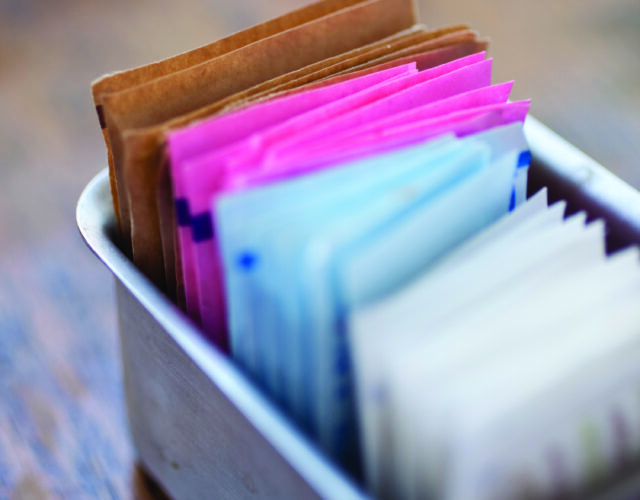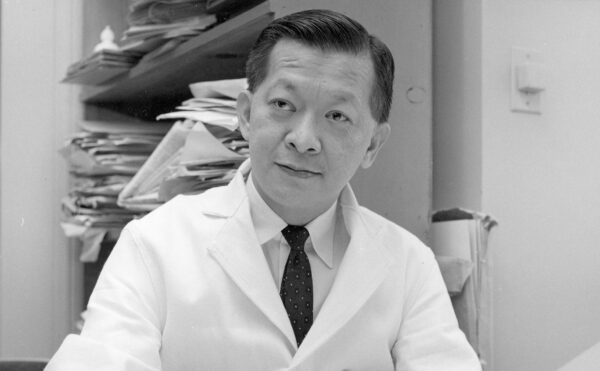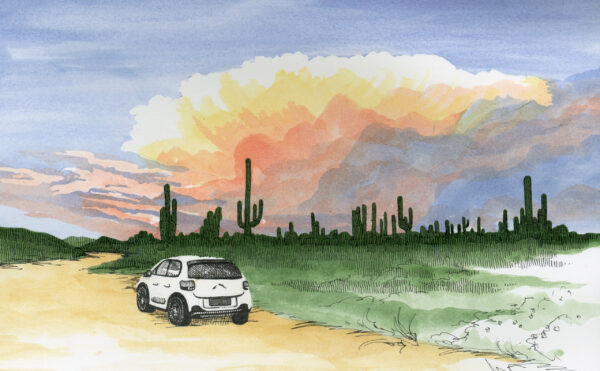You see them in almost every restaurant: those small paper packets, blue, yellow, or pink, emblazoned Equal, Splenda, or Sweet’N Low. In a little over 50 years artificial sweeteners have become a ubiquitous part of the dining experience. Where diners once found a sugar bowl, they’re now more likely to find a multicolored collection of single-serving chemicals.
One compound blazed a trail for other artificial sweeteners: saccharin. Three hundred times sweeter than sugar, with no apparent side effects, it was touted to consumers as the gateway to a world of sweetness without consequences. Over time the saccharin story grew more complicated; while the substance remained unchanged, perceptions of it have undergone almost alchemical shifts. In its 130-year history saccharin has been a laboratory accident, a wonder drug, a dangerous carcinogen, and a consumer cause célèbre.
The story of saccharin’s rise, its long reign as king of the artificial sweeteners, and its eventual decline illustrates a central tension within the American consumer’s psyche. When a company claims its product improves on nature, many consumers happily declare the product an example of scientific progress. Equally powerful, though, is the inclination toward skepticism—a wary eye for “faster, better, more” claims. From the beginning consumers and regulators wondered whether saccharin was too good to be true, whether its sweetness could truly be harmless. That underlying fear has never completely gone away despite the widespread use of artificial sweeteners today. The story of saccharin is a story of chemistry outside the lab, where things get complicated.
Discovery and Commercialization: The Early Years of Saccharin
Saccharin (C7H5NO3S) was discovered in 1878 in the Johns Hopkins University laboratory of Ira Remsen, a professor of chemistry. At age 21 Remsen had graduated with honors from the College of Physicians and Surgeons at Columbia University, earning an M.D. He soon abandoned his medical career to pursue chemistry, first at the University of Munich, then at the University of Göttingen, where he studied with Rudolph Fittig and began research on the oxidation of toluene isomers.
In Fittig’s lab Remsen also studied sulfobenzoic acids, eventually publishing 75 papers on these and related compounds, laying the groundwork for the discovery of benzoic sulfinide—saccharin. Remsen returned to the United States in 1876—bringing with him influential German ideas about chemistry education—and accepted a professorship at Johns Hopkins. There he continued his research on the oxidation of methylated sulfobenzoic acids and their amides.
In 1877 a Russian chemist named Constantin Fahlberg was hired by the H.W. Perot Import Firm in Baltimore. Fahlberg studied sugar, while H.W. Perot imported sugar. The company enlisted him to analyze a sugar shipment impounded by the U.S. government, which questioned its purity. H.W. Perot also hired Remsen, asking him to provide a laboratory for Fahlberg’s tests. After completing his analyses and while waiting to testify at trial, Fahlberg received Remsen’s permission to use the lab for his own research. Working alongside Remsen’s assistants, Fahlberg found the lab a friendly place. In early 1878 Remsen granted Fahlberg’s request to take part in the institute’s research.
One night that June, after a day of laboratory work, Fahlberg sat down to dinner. He picked up a roll with his hand and bit into a remarkably sweet crust. Fahlberg had literally brought his work home with him, having spilled an experimental compound over his hands earlier that day. He ran back to Remsen’s laboratory, where he tasted everything on his worktable—all the vials, beakers, and dishes he used for his experiments. Finally he found the source: an overboiled beaker in which o-sulfobenzoic acid had reacted with phosphorus (V) chloride and ammonia, producing benzoic sulfinide. Though Falhberg had previously synthesized the compound by another method, he had no reason to taste the result. Serendipity had provided him with the first commercially viable alternative to cane sugar.
As saccharin use rose, consumers, regulators, and competitors began to question its supposed harmlessness.
Remsen and Fahlberg published a joint article describing two methods of saccharin synthesis in February 1879. Though they specifically noted its taste—“even sweeter than cane sugar”—neither discoverer seemed interested in its commercial potential.
At least not initially. In 1884, after he had left Remsen’s lab and without notifying his codiscoverer, Fahlberg applied for German and American patents on a new method for producing saccharin more cheaply and in greater quantities. Remsen had long disdained industrial chemistry, considering himself a man of pure science. In 1886, though, Fahlberg filed another set of patents, claiming to be the sole discoverer of “Fahlberg’s saccharin.” Remsen, who wanted recognition rather than money, immediately protested to the chemistry community.
With his newly patented production method Fahlberg set up shop in New York City, where he and one employee produced five kilograms of saccharin a day for use as a drink additive. Offered in pill and powder form, saccharin’s popularity grew quickly. Doctors began to prescribe it to treat headaches, nausea, and corpulence. (Like sugar before it, saccharin became an all-purpose curative.) Canners used it as a preservative; diabetics used it to sweeten coffee or tea.
As saccharin use rose, consumers, regulators, and competitors began to question its supposed harmlessness. Fahlberg had tested saccharin in late 1882. After consuming 10 grams of the chemical, he waited 24 hours and experienced no adverse reactions. In fact, his body barely responded: almost the entire dose passed unmetabolized into his urine.
But by 1906, in response to such food-industry horror stories as Upton Sinclair’s The Jungle, Americans demanded government intervention. Thus Congress passed the Pure Food and Drug Act, the first attempt to regulate the nation’s food supply.
Enforcement of the new law fell to the Department of Agriculture’s Bureau of Chemistry and its head chemist, Harvey Washington Wiley. He had long crusaded to rein in what he saw as an out-of-control food industry. In 1908 Wiley proposed the first saccharin ban, taking his case straight to President Theodore Roosevelt.
Wiley’s stature as a chemist and sugar expert should have carried the day. In his meeting with Roosevelt he argued that saccharin, as a coal-tar derivative, couldn’t possibly be fit for human consumption—though at this point the scientific evidence remained inconclusive. A factory owner responded that his company had saved thousands of dollars by replacing sugar with saccharin. Wiley countered that saccharin threatened the health of everyone who consumed it. Roosevelt gruffly settled the matter, saying, “Anyone who says saccharin is injurious to health is an idiot. Dr. Rixey gives it to me every day.” Regulatory science, in the form of Wiley, had collided with industrial market priorities; the anecdotal evidence of a single influential consumer—President Roosevelt, whose personal physician had prescribed saccharin to help his patient slim down—had trumped both.
In the years to come this pattern would repeat itself. Uncertain science provoked regulatory action—dismaying major segments of industry and the public, while invigorating those who saw regulators as protectors of the public welfare. Industry and regulators each had their own scientists and often their own incompatible sets of scientific evidence. The notion of scientific consensus began to break down as questions of safety became more complicated; the relationship between industry and regulators grew antagonistic as medical evidence became less conclusive and more open to interpretation.
With scientific consensus on safety issues no longer tenable, regulations would be increasingly made in public, often by the public—those consumers who considered themselves just as capable of interpreting the evidence as the so-called experts. For saccharin this regulation by the public reached its apogee in the 1970s, but the pattern had established itself as early as 1908.
Saccharin suffered minor setbacks in the coming decades, but every time it emerged more popular than ever. As a check on Wiley’s growing power and at the request of industrialists, in 1910 President Roosevelt created the Referee Board of Consulting Scientific Experts. The board’s first task was to examine the effect of sodium benzoate and saccharin on human health. The board, chaired by Ira Remsen, declared saccharin harmless in small doses. The next year Wiley won a small victory. He argued that because of saccharin’s ubiquity, average consumers would ingest more of the sweetener than allowed for by Remsen’s scientists. From July 1912 food regulations would treat saccharin as an “adulterant,” prohibiting its use in processed foods. Industry lawyers fought back, and regulators wavered. A March 1912 decision upheld the earlier ban but also declared the evidence for saccharin’s harmfulness as weak. Instead, it argued against replacing sugar with saccharin because the former possessed food value while the latter did not. Of course, this point made saccharin immensely popular for dieters since it provided sweetness without calories. The pattern continued with interest groups fighting over the definition and consequences of “incontrovertible scientific evidence.”
The ban on saccharin in processed food was the outcome of a bureaucratic stalemate between regulators and industry. No incontrovertible evidence proved saccharin harmful at regular doses. Both sides offered evidence to support their claims, and neither could agree on a common definition of “harmful.” Because no objective test existed, any experimental data was by definition controversial.
Whatever its scientific merit, the prohibition had little effect on public perception. Though saccharin couldn’t be used in processed food, it could be sold directly to consumers. When World War I caused a sugar shortage and consequent price spike, Monsanto, then the largest saccharin producer, took its case to the public in full-page ads, arguing that widespread use of saccharin could save the country millions of dollars. Price-conscious consumers responded, buying up saccharin tablets for 15 cents a box at local drugstores. When the war ended, saccharin use dipped as consumers returned to sugar. U.S. entry into World War II in 1941 provoked another sugar shortage, and saccharin returned as a sugar substitute. But post–World War II, changing American eating habits meant saccharin soon became more than just an alternative sweetener.
The Rise of Saccharin and Scientific Controversy
Had saccharin remained merely a sugar alternative, important only to a relatively small number of diabetics and weight watchers during peacetime, it probably would not have caught the eye of government regulators and scientists. In the aftermath of World War II, though, saccharin production remained high. Fundamental changes in the American diet meant fewer people prepared meals at home, relying instead on preprocessed food. Presweetened products, often containing inexpensive saccharin—the output of an increasingly large food-processing industry—alarmed nutritionists, regulators, and health officials. While saccharin consumption increased, the debate over its safety was never truly settled. Science, to the public, had issued too many contradictory or inconclusive opinions, so when the decision about saccharin fell to individuals, most responded to their desire for a no-consequences sweetener.
Others, like Harvey Washington Wiley before them, were skeptical. A belief in the inherent healthiness of “natural” food led some people to decry the increasing artificiality of the American diet. Avis DeVoto, a friend of Julia Child and an editor at Alfred Knopf, remained unimpressed by saccharin, especially by its increasing use in cookbooks. In 1957 she wrote, “Desserts, of which there is a fat section, are incredible—sweetened with saccharine [sic] and topped with imitation whipped cream! Fantastic! And I do believe a lot of people in this country eat just like that, stuffing themselves with faked materials in the fond belief that by substituting a chemical for God’s good food they can keep themselves slim while still eating hot breads and desserts and GUNK.” DeVoto despaired, but also perfectly captured saccharin’s appeal: sweetness without consequences.
Three trends converged: increasing government regulation in the food-processing industry, the rise of artificial sweeteners, and the growing complexity and sophistication of health science.
Partly in response to growing unease among regulators and the public, Congress passed the Food Additives Amendment in 1958. In preparing its legislation Congress heard testimony from members of the scientific community. For the first time in connection with food additives, scientists used the c-word: cancer. Representative James J. Delaney, a Democrat from New York, pushed hard for the addition of language specifically outlawing carcinogens. In its final form the “Delaney Clause” required the U.S. Food and Drug Administration (FDA) to prohibit the use of carcinogenic substances in food. Seemingly uncontroversial at the time—who would support adding cancer-causing agents to food?—it later proved contentious. Legislators had disastrously underestimated the data necessary to definitively declare a substance carcinogenic.
The same year, the Cumberland Packing Corporation introduced Sweet’N Low, a mixture of saccharin and cyclamate, another artificial sweetener. The two chemicals balanced each other, with cyclamate blunting the bitter aftertaste of saccharin. Sweet’N Low arguably tasted more like real sugar, and those little pink packets brought artificial sweeteners into diners and coffee shops. Meanwhile, the use of artificial sweeteners continued to increase among weight-conscious consumers. Between 1963 and 1967 artificially sweetened soft drinks (Coca-Cola’s Tab, for example) nearly tripled their market share, growing to over 10% of the soda market.
In 1882 Constantin Fahlberg had declared saccharin harmless because he suffered no adverse effects 24 hours after taking a single dose. Similarly, Harvey Washington Wiley’s turn-of-the-century “poison squads” had declared a substance safe if the tester—a human guinea pig—remained healthy after ingestion. But post–World War II health science had begun investigating subtler, long-term effects. Research methodology had changed accordingly: studies observed a longer span of time, for example, and tried to control for a wider range of variables. Researchers shifted away from unstructured human testing toward animal testing that included control groups. Such research produced more and better data but increased complexity. No longer could a substance be labeled simply “poison” or “not poison.” The results of these sophisticated tests demanded sophisticated interpretation.
In the late 1960s three trends converged: increasing government regulation in the food-processing industry, the rise of artificial sweeteners, and the growing complexity and sophistication of health science. One of the first results of this convergence was the ban on cyclamate. Two 1968 studies linked the chemical to bladder cancer. The FDA cited the Delaney Clause in recommending a ban, which was enacted the following year. That left only one artificial sweetener on the market: saccharin. In 1970 oncologists at the University of Wisconsin Medical School published the results of a clinical study showing a higher instance of bladder cancer among rats who consumed saccharin daily. Subsequent tests seemed to support the initial results, and in 1972 the FDA removed saccharin from the list of food additives “generally recognized as safe.” Peter B. Hutt, chief legal counsel for the FDA, stated that, “If it causes cancer—whether it’s 875 bottles a day or 11—it’s going off the market.”
Saccharin producers and commercial consumers recognized the FDA’s move as a precursor to an outright ban. Large chemical companies—Monsanto, Sherwin-Williams, and Lakeway Chemicals—began assembling their own evidence to oppose prohibition. Soda companies expected a painful financial hit, as did makers of diet food. But they also knew the process could take years, as the FDA ordered new tests, analyzed the data, and—crucially—responded to public and political pressure.
By 1979, 44 million Americans used saccharin daily.
By 1977 a saccharin ban looked likely. The Cumberland Packing Corporation, which had presciently reformulated Sweet’N Low in the shadow of the cyclamate ban, vowed to fight any regulation. Marvin Eisenstadt, the president of the company, appeared on television and radio to argue his case. He denied the scientific validity of animal testing and declared access to saccharin a consumer right. He helped draft a two-page ad from the Calorie Control Council, the industry group he headed. The ad appeared in the New York Times explaining “why the proposed ban on saccharin is leaving a bad taste in a lot of people’s mouths.” The ad described the ban as “another example of BIG GOVERNMENT” and recommended action. “Fortunately, we can all conduct our own experiment in this matter. It’s called an experiment in democracy. . . . Write or call your congressman today and let him know how you feel about a ban on saccharin.”
In the week after the saccharin ban went into effect in 1977, Congress received more than a million letters. Marvin Eisenstadt and other public relations–savvy producers had turned the saccharin debate into a PR operation, and the public had responded. The Delaney Clause, as the FDA interpreted it, required a ban on any known carcinogen in the food supply. But the original legislation failed to account for the complexity of scientific data. The clause’s premise of scientific consensus based on objective evidence and shared expertise no longer applied to the real world, if it ever had. Scientists couldn’t agree on fundamental questions: What is a carcinogen? What daily dosage of a chemical might be reasonable for testing toxicity? Did the elevated risk of cancer in rats translate to an elevated risk in humans? Health science couldn’t yet answer those questions definitively. But in the absence of incontrovertible scientific evidence, Marvin Eisenstadt could frame the debate as average citizens versus an encroaching big government.
The FDA understood the weakness of the existing laws and breathed a sigh of relief when, a week after the ban, Senator Ted Kennedy of the Senate Subcommittee on Health and Scientific Research moved to forestall the ban. The Saccharin Study and Labeling Act passed that year, declaring that all saccharin products would carry a warning label. It also imposed a two-year moratorium on any government action to remove saccharin from the market. More studies were needed, according to Congress.
In response, Sweet’N Low sales skyrocketed. Those sales included longtime buyers stocking up in case of a ban, but the free publicity also brought in new customers. By 1979, 44 million Americans used saccharin daily. Consumers voted with their dollars.
Congress renewed the moratorium every two years until 2000, when a National Institute of Environmental Health Sciences (NIEHS) study declared the earlier research invalid. The high dosages of saccharin given to the rats were a poor analog for human consumption, as rat digestion works differently from that of humans. The NIEHS recommended that Congress repeal the Labeling Act, officially declaring saccharin safe for human consumption.
Finally, though, it wasn’t government regulation that toppled saccharin from its throne as king of the artificial sweeteners—at least not directly. The threat of a saccharin ban led producers to research alternatives. While saccharin—300 times sweeter than sugar—languished in the shadow of a potential ban, a new generation of artificial sweeteners flourished. In 1965 aspartame, which is 200 times sweeter than sugar, was discovered; in 1976 sucralose—600 times sweeter; and in 2002 neotame—7,000 to 13,000 times sweeter than sugar. Today, saccharin, once the undisputed king of artificial sweeteners, lags behind its newer counterparts, replaced by the next sweetest thing.
Sweet and Sour: A History of Controversy
From the beginning Americans have had mixed feelings about artificial sweetness. Saccharin originally appealed to frugal consumers. As Americans became more diet conscious, it became the no-calorie alternative to sugar. Those weight watchers wanted sweetness without consequences and manufacturers obliged. Newer, sweeter compounds appeared in saccharin’s wake.
But while eagerly embracing these improvements, many remain suspicious about chemicals in their food. Stores like Whole Foods Market, movies like Super Size Me, and books like Michael Pollan’s The Omnivore’s Dilemma exemplify the turn away from industrialized, processed food.
The organic-food movement revives a long-held suspicion about how our food reaches our dinner tables. It also evokes a suspicion of science, specifically the nightmare image of Frankenfood. When it comes to food, Americans want the benefits of scientific progress but without all that science: better, faster, more—but it has to be “all natural.”
That contradiction has played a major role in the history of artificial sweeteners. All three “first-generation” sweeteners—cyclamate, saccharin, and aspartame—have been linked to negative health effects. Cyclamate, introduced in 1951, was banned in the United States in 1970. The cyclamate ban reinvigorated the debate over saccharin’s safety, leading to the Saccharin Study and Labeling Act. And aspartame, introduced in 1981, was linked to a supposed increase in brain tumors.
In all three cases researchers later declared the products safe. But the debate over safety received much press attention, and suspicion about artificial sweeteners has seeped into the collective consciousness. A Google search for any of the recently developed artificial sweeteners—acesulfame-K, sucralose, alitame, and neotame—invariably yields Web pages devoted to “the truth” about these chemicals.
Some of these pages are well-intentioned, if often misinformed or simplistic. Others have less noble agendas. One example, thetruthaboutsplenda.com asks, “Do you know what your children are eating?” The site answers that “Splenda is not natural; it is a chlorinated artificial sweetener.” True, depending on the definition of natural in use and certainly effective in raising consumer suspicions. And who is the unbiased party helping spread the truth about Splenda? The Sugar Association, representing sugar-beet and sugar-cane producers across America.




